The recipe for Juicy Oven Baked Chicken Bites is great for the whole family and only takes 20 minutes to make. They are tender, flavorful, and can be used for any meal of the week.
Everyone in the family, including all your picky eaters, will absolutely love these baked chicken bites. Their savory flavor, combined with their easy-to-eat size, makes them an instant hit—and you’ll also love that they’re a wholesome, healthy source of lean protein!.
Let me tell you, this recipe hits the ball out of the park, and not just in terms of taste. This chicken bites recipe is also super easy, with everyday ingredients you probably have stocked in your pantry and only a few minutes of prep time.
Looking for a quick, filling meal that can be used for anything from weeknight dinners to party appetizers? Then learning how to cook chicken bites on the stove might be just what you need. As someone who has made this dish many times (sometimes successfully, sometimes not so much!), I’m excited to share my tried-and-true tips for making juicy, golden chicken bites that will make everyone want more.
Why Stovetop Chicken Bites Are a Game-Changer
Here’s why cooking chicken bites on the stove is such a great way to cook them before we get to the how-to.
- Quick cooking time (just 5-8 minutes!)
- Perfect browning that’s hard to achieve in an oven
- Total control over the cooking process
- Versatility for countless recipes and flavor profiles
- Minimal equipment needed – just a good pan!
I remember the first time I tried to make chicken bites on the stove. I crammed too many bites into the pan, so they were soggy and steamed instead of crispy and golden. You don’t have to worry because I’ve already done everything wrong!
Choosing Your Chicken: The Foundation of Flavor
The success of your stovetop chicken bites starts with selecting the right cut of chicken.
Chicken Breast vs. Chicken Thighs
Chicken breast is popular for its:
- Lean protein content
- Mild flavor that takes on seasonings well
- Quick cooking time
Chicken thighs offer
- Juicier, more flavorful meat due to higher fat content
- More forgiving cooking time (less likely to dry out)
- Richer flavor profile
Personally, I like to use chicken breasts when I want to keep things light and chicken thighs when I want to make a casual family meal. If you use chicken breast, you might want to brine it in a saltwater solution for 30 minutes to an hour to keep it from drying out while it’s cooking.
Fresh vs. Frozen
While frozen chicken is convenient, fresh chicken will give you the best texture and flavor for stovetop chicken bites. If you’re using frozen chicken, thaw it completely and pat it dry with paper towels before cooking. This step is crucial – excess moisture will prevent proper browning and can result in soggy chicken.
Prepping Your Chicken Bites for Stovetop Success
Cutting Technique
For evenly cooked chicken bites, aim for uniform size – about 1-inch cubes work perfectly. Remember:
- Cut against the grain when possible
- Trim any excess fat or tendons
- Try to make the pieces relatively similar in size for even cooking
The Power of Seasoning
Don’t underestimate the impact of good seasoning! At minimum, you’ll want salt and pepper, but here are some of my favorite combinations:
- Classic: Salt, pepper, garlic powder, onion powder, paprika
- Spicy: Salt, pepper, chili powder, cayenne, smoked paprika
- Italian-inspired: Salt, pepper, Italian seasoning, garlic powder
- Asian-inspired: Salt, pepper, ginger powder, garlic powder, five spice
Pro tip: Season your chicken about 15-30 minutes before cooking to allow the flavors to penetrate the meat.
To Coat or Not to Coat?
Coating chicken bites before cooking on the stove can add texture and help retain moisture. Here are some options:
Plain flour coating:
- Creates a light, golden crust
- Helps protect the chicken from drying out
- Simple and effective
Breadcrumb coating:
- Provides extra crunch
- Panko breadcrumbs offer particularly crunchy texture
- Works best with an egg wash binding
Cornstarch coating:
- Creates a light, crispy coating
- Is gluten-free
- Great for Asian-inspired dishes
I personally love using a light dusting of flour with some seasonings mixed in for everyday cooking – it creates just enough texture without being too heavy.
The Art of Stovetop Cooking: Step-by-Step Guide
Now let’s get cooking! Here’s my foolproof method for perfect chicken bites on the stove:
Choosing the Right Pan
A heavy-bottomed skillet is ideal for even heat distribution. Cast iron skillets are excellent for this purpose, but any good-quality skillet will work. Non-stick skillets can also be used but may not provide the same level of browning.
Oil Selection and Temperature
Select a cooking oil with a high smoke point:
- Vegetable oil
- Canola oil
- Avocado oil
Avoid using olive oil for high-heat cooking, as it has a lower smoke point and may burn, imparting a bitter flavor to your chicken bites.
Step-by-Step Cooking Process
- Pat dry your chicken pieces with paper towels to remove excess moisture
- Season generously with your chosen spices
- Heat your pan over medium-high heat until it’s hot
- Add oil – enough to coat the bottom evenly (about 1/4 inch deep)
- Test the temperature by dropping a small piece of chicken in – it should sizzle immediately
- Add chicken in batches – don’t overcrowd! Leave space between pieces
- Cook for 3-4 minutes without moving to develop a good crust
- Flip or stir and cook another 2-3 minutes until golden brown
- Check internal temperature – should be 165°F (74°C)
- Remove to a paper towel-lined plate to drain excess oil
The #1 Mistake to Avoid: Overcrowding the Pan
I cannot stress this enough – overcrowding is the enemy of crispy chicken bites! When you put too many pieces in the pan at once, the temperature drops and the chicken steams instead of searing. This results in pale, soggy chicken instead of golden, crispy bites.
It’s better to cook in 2-3 batches and have amazing results than to rush and end up with mediocre chicken.
Serving and Pairing Ideas
Now that you’ve mastered cooking chicken bites on the stove, here are some delicious ways to serve them:
Dipping Sauces
The right sauce can elevate your chicken bites to new heights:
- Honey mustard
- BBQ sauce
- Ranch dressing
- Sweet chili sauce
- Buffalo sauce
- Teriyaki sauce
Meal Ideas
Chicken bites are incredibly versatile:
- Salad topper: Add to fresh greens with your favorite dressing
- Grain bowls: Serve over rice or quinoa with roasted veggies
- Wraps and tacos: Stuff into tortillas with fresh toppings
- Pasta dishes: Toss with pasta and sauce for a quick meal
- Appetizers: Serve with toothpicks and dipping sauces
Storing and Reheating
Made too many chicken bites? No problem! Here’s how to store and reheat them:
Refrigerator storage:
- Keep in an airtight container for up to 3-4 days
- Make sure they’re completely cooled before storing
Freezer storage:
- Place in freezer-safe containers or bags
- Can be frozen for up to 3 months
- Thaw in refrigerator before reheating
Reheating methods:
- Stovetop: Reheat in a skillet over medium heat until warmed through
- Oven: Warm at 350°F for 10-15 minutes for the best texture
- Microwave: Use short bursts of heat (30 seconds at a time) to avoid drying out
FAQs About Cooking Chicken Bites on the Stove
Q: How can I tell if my chicken bites are cooked through without a thermometer?
A: Cut into the thickest piece – the juices should run clear, and the meat should be opaque throughout with no pink remaining.
Q: How long should I cook chicken bites on the stove?
A: Generally, it takes about 5-8 minutes to cook 1-inch chicken bites on medium-high heat. The exact time depends on the size of your bites and the heat of your stove.
Q: Why are my chicken bites dry?
A: Overcooking is the most common cause of dry chicken bites. Use a meat thermometer to monitor the internal temperature and avoid cooking past 165°F. Brining chicken breast beforehand can also help retain moisture.
Q: Can I add vegetables to the pan while cooking the chicken?
A: Yes! Just add them at the appropriate time depending on how long they take to cook. Quick-cooking vegetables like bell peppers and zucchini can go in towards the end of cooking.
Final Tips for Perfect Stovetop Chicken Bites
After years of cooking chicken bites on the stove, here are my top tips for success:
- Use room temperature chicken when possible – cold chicken straight from the fridge can cook unevenly
- Don’t flip too early – let the crust develop before turning
- Trust your eyes and nose – golden brown color and a delicious aroma are good indicators
- Let rest for 2-3 minutes after cooking to allow juices to redistribute
- Season well – chicken loves flavor, don’t be shy with seasonings!
Cooking chicken bites on the stove is one of those fundamental cooking skills that seems simple but makes a huge difference in your everyday meals. Once you’ve mastered this technique, you’ll have a quick and delicious protein option at your fingertips for countless meals.
What’s your favorite way to season chicken bites? Drop a comment below – I’d love to hear your variations and try them myself!

How do you keep chicken from drying out in the oven?
Some ways to keep your chicken from drying out are to cook it at a higher temperature for less time. Long, slow cooking is the worst thing you can do for boneless chicken breasts!.
Recipe Step by Step
I am going to highlight a few key steps in the recipe here, but make sure to jump down to the recipe card for comprehensive instructions on how to make oven-baked chicken bites.
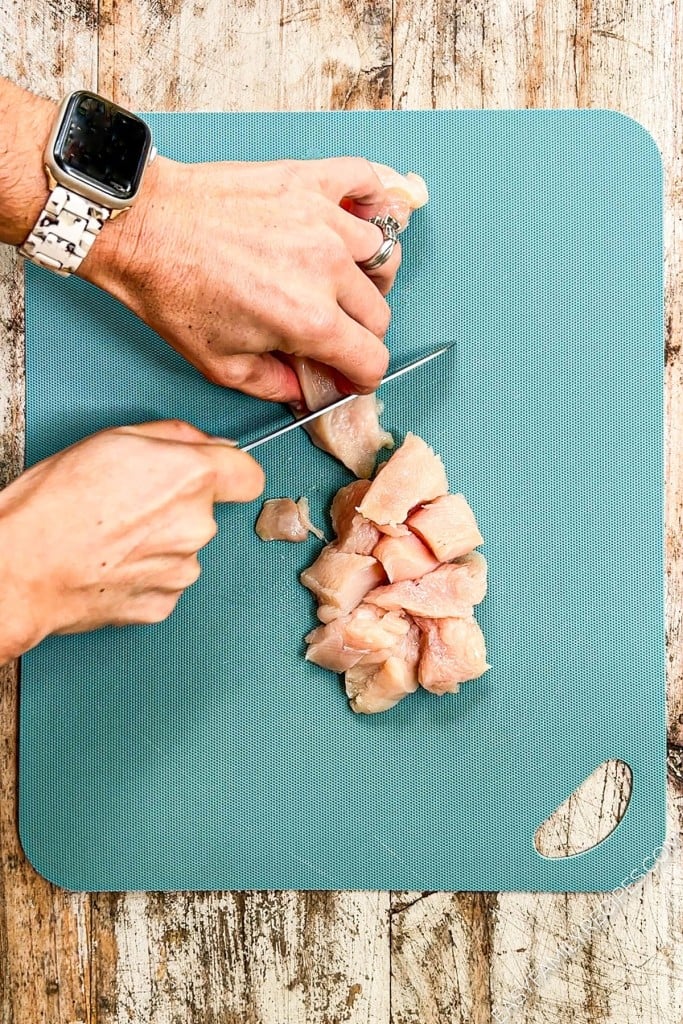
Cut the chicken into bite-sized pieces.
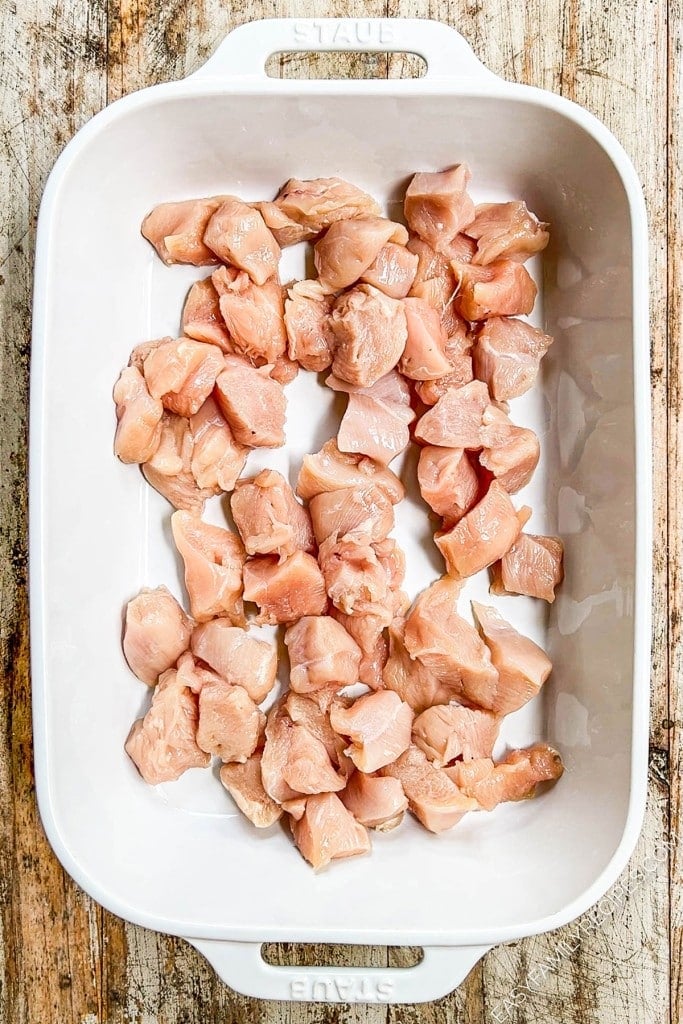
Place the cut chicken chunks into a casserole dish.
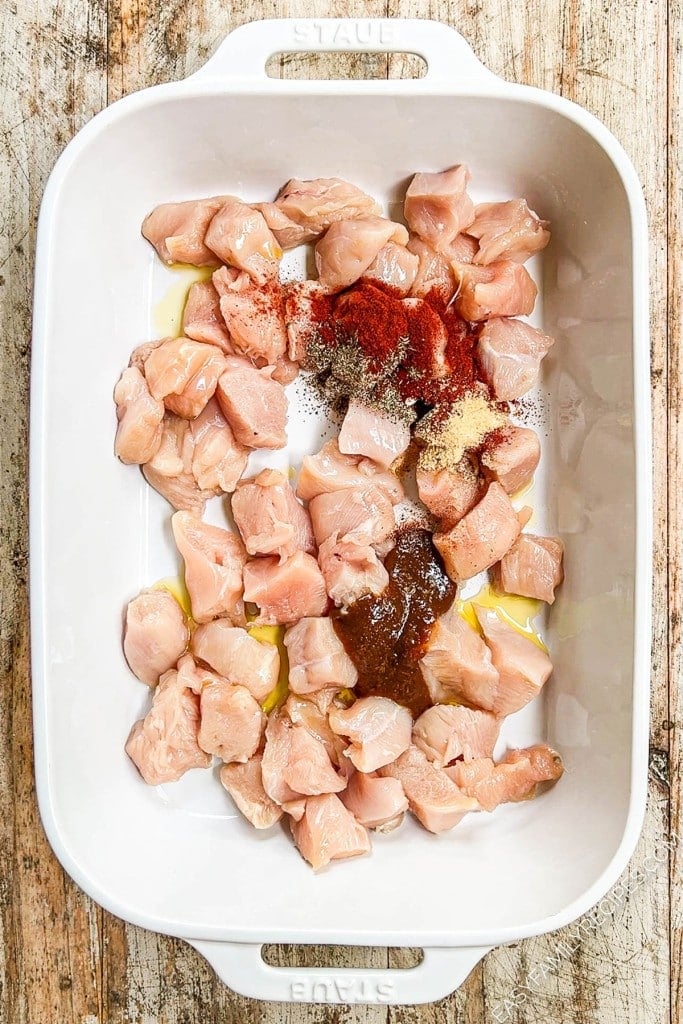
Add the oil and seasonings.
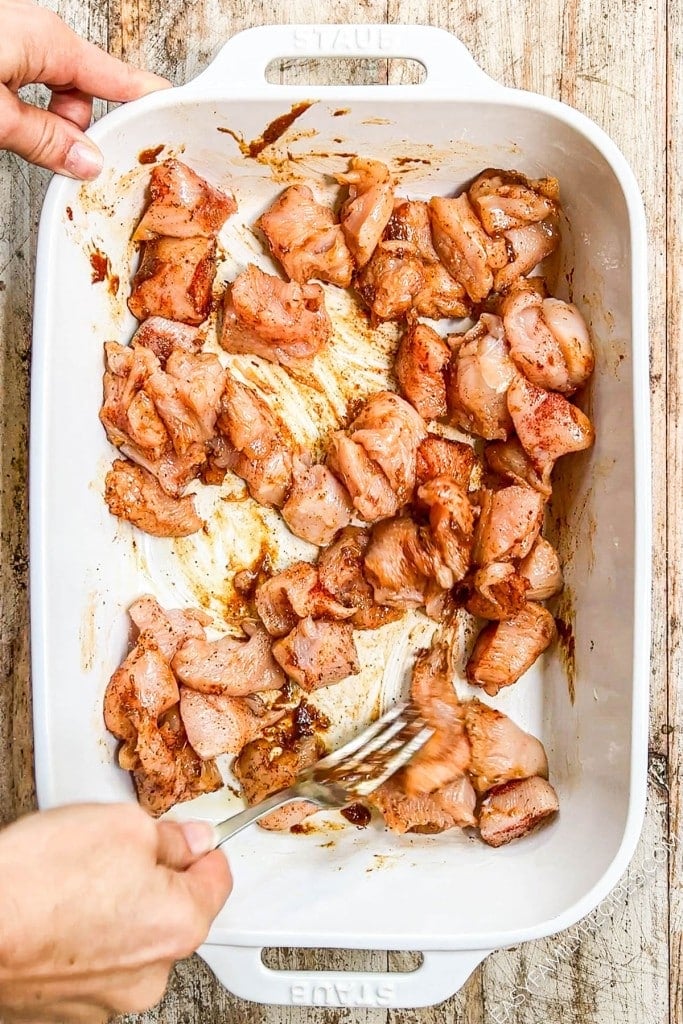
Stir until the chicken is evenly coated.
- If you cut the chicken into even pieces, the chicken bites will cook evenly and all finish baking at the same time.
- Coat the chicken bites well. For the most flavor in every bite, make sure the oil, spices, and herbs are spread out evenly on the chicken.
- Chicken bites need space—just like teens, they need it! If you want golden, crispy edges, don’t pack them all into the baking dish at once; they should all be in a single layer.
- Too much cooking will make your chicken bites dry and tough. An instant-read thermometer is the best way to tell when your chicken is done because the time will depend on the size of your chicken bites and the exact temperature of your oven.
Here are some things you can do to speed up this recipe even more if you need to make it quickly.
- Let the butcher prepare your chicken. Instead of cutting the chicken yourself, buy chicken tenders or nuggets that are already cut up.
- Don’t use jars of spices. Instead, buy a seasoning blend from the store and don’t measure out all the spices for the recipe.
- Before making the chicken bites, you can measure out and mix the seasonings. Then, you can keep them at room temperature until you’re ready to use them. (If you make it often, just keep a jar of the seasoning mix in the pantry!)
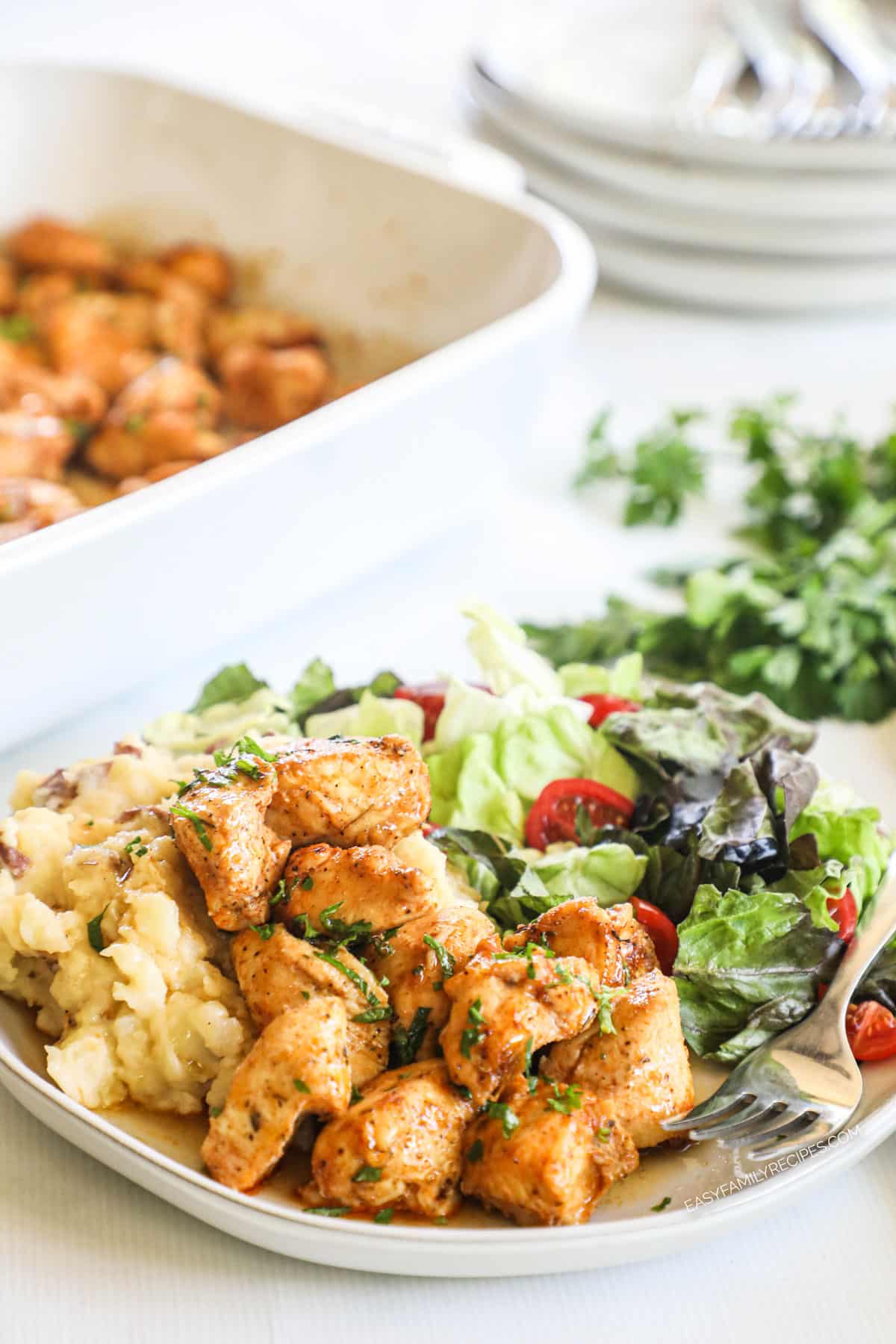
Making this chicken bites recipe into a freezer meal is simple! Follow the steps below and you can store this recipe in the freezer for up to 6 months.
